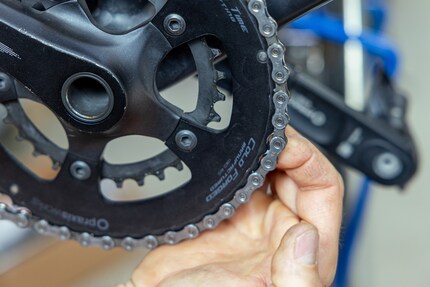
Guide
Stories from the bike workshop: the flat tyre
by Patrick Bardelli

The chain’s one of the most stressed parts of your bicycle. It transfers the pedalling power to the rear wheel via the cranks, thereby driving the bike. And yet, it’s often criminally neglected.
It dawned on me last summer, when a mechanic at Hilite Bikes in Basel looked at me a little surprised and said: «You’ve been riding the chain on your bike for a while, right?». Turns out I should’ve taken care of it. But I didn’t.
Anyway, I’m trying to learn from my mistakes, which is why I’m at Elia Widmer’s workshop again today. Elia’s a trained toolmaker and involved in constructing Hilite Bikes’ customised bicycles. He also works as a bike mechanic, taking care of minor and major ailments on road bikes and the like. I recently watched him deal with a puncture on a tubeless tyre. Here’s the full article on it:
Today, it’s all about the wear and tear of bike chains. The more you use your bike, the longer it gets. This is because the small rollers on the chain links are worn down. The smaller they get, the longer the chain. This means the distance between the individual links no longer corresponds to the distance between the sprockets on the chainring. And so, the chain no longer runs smoothly over the teeth. If it slips, you step into a void. Or, worst case, the chain’ll break. What’s more, chainrings and the cassette wear out more quickly, so it’s not just the chain that will need replacing.

The tool of choice for determining chain wear is a so-called chain wear gauge. It measures the distance between the individual links. But you can also do this without a tool. If you have a 2x chainring at the front, pull the chain off the large chainring with your finger. If you can pull it out by three or four millimetres, it’s worn out. There are a few millimetres more on the small one, as the chain play is distributed over a smaller area.
The lifespan for off-the-shelf chains varies. Depending on how often and where you use your bike, the weather, quality and care of the chain, it should last around 700 to 3,000 kilometres. Elia Widmer says pragmatically: «If you’re not sure about this, just replace the chain once a year to be on the safe side.» Also make sure to avoid so-called cross chaining (page in German). It makes the chain run diagonally and increases friction and strain.

The chain should never run without a lubricant. It’s not that important if you’re using oil or wax. All that matters is that it’s not metal on metal. However, a well-greased chain will attract dirt. So make sure to clean it regularly. The same goes for the cassette.
According to Elia Widmer, bikers can also remove the chain completely and clean it in a bucket, for example. «Just bear in mind that the old chain lock needs to be replaced, as it won’t lock nearly as well as before,» he explains. This, of course, results in extra costs.

According to Elia, the advantage of a waxed chain over an oiled one is that it puts less friction on the chainring and the cassette, which makes it practically maintenance-free. In addition, less dirt sticks to it. The downside? A waxed chain is more likely to rust in wet conditions. This means you need to dry it after every ride in the rain. Elia adds that maintaining a waxed chain is a little more expensive, but it reduces wear and tear.

Want to establish the condition of your bike chain before setting off for the first time after the winter break? You can do this by looking at the chainring or with a chain wear gauge. The latter’s more precise. If the chain’s worn through, you have no choice but to get a new one. And don’t forget to clean it regularly. I’ve linked a few suggestions for you.
Of course, there are similar products from other suppliers available in our virtual bike workshop. The featured products include chain wax such as the Graphenwax 2.0 by Absolute Black.
More stories from the bike workshop coming up. The topics: new tubeless tyres for gravel bikes and no more squeaky brakes
From radio journalist to product tester and storyteller, jogger to gravel bike novice and fitness enthusiast with barbells and dumbbells. I'm excited to see where the journey'll take me next.
Practical solutions for everyday problems with technology, household hacks and much more.
Show all